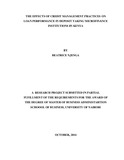| dc.description.abstract | This study was set to determine the effect of credit management practices on loan
performance in Deposit Taking Microfinance institutions in Kenya. The study used a
descriptive research design. This study, focused on nine (9) MFIs licensed under the
central bank of Kenya (CBK, 2013). The study used a census study whereby the entire
population was studied as opposed to selecting a sample. The DTMs that were studied
include Kenya Women Finance Trust (KWFT) DTM Limited, Faulu Kenya DTM
Limited, Small and Micro Enterprise Programme (SMEP) and Remu DTM Limited. The
study used both primary and secondary data. Primary data was collected by use a
structured questionnaire. The data was collected from secondary sources since the nature
of the data is quantitative. The secondary data was obtained from financial reports of
micro finance institutions. Secondary data from the Central Bank of Kenya (CBK)
reports and library was reviewed for completeness and consistency in order to statistical
analysis. The study focused on four key variables namely the dependent variable (Loan
performance which was measured using debts. The results of the regression equation
revealed that the predictors that were significant contributors to the 68.9% of explained
variance in loan performance were (R2=.689).The predictors that were significant were
profitability since an increase in profitability by 0.224 resulted into a corresponding
increase in loan performance of deposit taking microfinance institutions. This means that
there was positive relationship between the variables. The study concluded that it was
important for deposit taking microfinance institutions in Kenya to maintain an
appropriate balance between provision of credit and collections as a key factor, critical to
the survival and ultimate success of DTM’s in Kenya. The findings also revealed that
although most deposit taking microfinance institutions implemented credit management
practices, the gross loan portfolio increase steadily over the years. Also, it was observed
that the amount of non-performing loans increased progressively. This rate of default
could be as a result of poor investment decisions by the borrowers due to lack of
professional advice by deposit taking microfinance institutions on how to choose and
select viable investments that can yield profitability. The study further concluded that
some microfinance institutions were a bit lenient while giving out credit facilities to their
customers. Some of the credit officer had too much trust on their customers and thus
failed to observe all the credit management practices while giving out credit. This
however, led to an increase in the amount of nonperforming loans leading to poor loan
repayment and thus poor financial performance. The limitation of this study was time
constraints, limited financial resources and geographic distance between Deposit Taking
Microfinance Institutions in Kenya. Time and geographical constraints were overcome by
the utilization of professionally trained research assistants without compromising the
validity and reliability of the research findings, while the limited financial resources
available were spent on research activities that could not be undertaken solely by the
researcher. | en_US |

